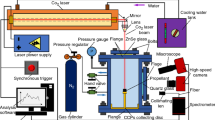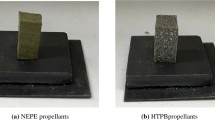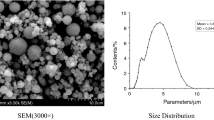Abstract
Glycidyl azide polymer (GAP)/Hexanitrohexaazaisowurtzitane (CL-20) composite propellants have significant advantages, such as high energy density and low characteristic signal. However, the lack of understanding of its ignition combustion and agglomeration mechanism limits its large-scale engineering application in solid rocket motors. In this paper, the ignition, combustion and agglomeration processes of GAP/CL-20 propellants were studied in detail by using modern analytical and testing instruments, such as high-speed cameras, CO2 laser ignition devices and laser particle size analyzers. First, the ignition and combustion process of the GAP/CL-20 composite propellant were observed with a high-speed camera, and its ignition and combustion mechanism were analyzed. On the basis of the BDP model, a multiple flame structure model suitable for the GAP/CL-20 composite propellant was proposed. Then, the agglomeration of aluminum particles in the combustion process of the GAP/CL-20 composite propellant was observed, and an agglomeration mechanism suitable for the GAP/CL-20 composite propellant was proposed based on the pocket model and skeleton layer theory. Subsequently, the particle size distribution, micromorphology and crystal structure of the condensed phase combustion products were analyzed. The particle size distribution of the condensed combustion products (CCPs) showed three modes, and the CCPs contained active aluminum, which indicated that aluminum particles were not fully oxidized during the combustion process of the propellant. Finally, several further research directions were proposed. The research results may have reference value for the engineering application of GAP/CL-20 propellants.













Similar content being viewed by others
References
Turcotte R, Vachon M, Kwok QS, Wang R, Jones DE. Thermal study of HNIW (CL-20). Thermochim Acta. 2005;433:105–15.
Viswanath JV, Venugopal KJ, Rao N, Venkataraman A. An overview on importance, synthetic strategies and studies of 2,4,6,8,10,12-hexanitro-2,4,6,8,10,12-hexaazaisowurtzitane(HNIW). Def Technol. 2016;12:401–18.
Ordzhonikidze O, Pivkina A, Frolov Y, Muravyev N, Monogarov K. Comparative study of HMX and CL-20. J Therm Anal Calorim. 2011;105:529–34.
Dai Z, Wu J, Xiang L, Zhao M. Preliminary study of properties of high energy and low signature CL-20 based solid propellants. Chem Propellants Polym Mater. 2009;7(6):48–50.
Zhou S, Wu F, Tang G, Wang Y, Pang A, Song H, Wang Y. Influence of CL-20 content and its particle size gradation on combustion performance of NEPE propellants. Chin J Explos Propellants. 2020;43(2):195–202.
Li W, Wang W, Wang F, Fu X, Zhang W. Synthesis and performance of schiff base type liquid crystalline ionomer containing sulfo group. Chem Propellants Polym Mater. 2016;14(4):73–83.
Yuan L, Liu T, Cheng S. The combustion characteristics of GAP gumstock propellants. 32th AIAA/ASME/SAE/ASEE Joint Propulsion Conference and Exhibit, Lake Buena Vista, FL, July 1–3, 1996.
Liu L, Ao W, Wen Z, Zhang Y, Lv X, Qin Z, Liu P. Combustion promotion and agglomeration reduction of the composite propellant using graphene. Aerosp Sci Technol. 2021;118:106988.
Ao W, Fan Z, Liu L, An Y, Ren J, Zhao M, Liu P, Li L. Agglomeration and combustion characteristics of solid composite propellants containing aluminum-based alloys. Combust Flame. 2020;220:288–97.
Li L, Chen X, Zhou C, Zhu M, Musa O. Experimental investigation on laser ignition and combustion characteristics of NEPE propellant. Propellants Explos Pyrotech. 2017;42:1095–103.
Beckstead MW, Hightower JD. Surface temperature of deflagrating ammonium perchlorate crystals. AIAA J. 1967;5(10):1785–90.
Beckstead MW, Derr RL, Price CF. A model of composite solid-propellant combustion based on multiple flames. AIAA J. 1970;8(12):2200–7.
Beckstead MW, Puduppakkam K, Thakre P, Yang V. Modeling of combustion and ignition of solid-propellant ingredients. Prog Energy Combust Sci. 2007;33:497–551.
Zhou S, Zhou X, Tang G, Guo X, Pang A. Differences of thermal decomposition behaviors and combustion properties between CL-20-based propellants and HMX-based solid propellants. J Therm Anal Calorim. 2020;140:2529–40.
Takahashi K, Oide S, Kuwahara T. Agglomeration characteristics of aluminum particles in AP/AN composite propellants. Propellants Explos Pyrotech. 2013;38:555–62.
Ao W, Liu X, Rezaiguia H, Liu H, Wang Z, Liu P. Aluminum agglomeration involving the second mergence of agglomerates on the solid propellants burning surface: experiments and modeling. Acta Astronaut. 2017;136:219–29.
Cohen NS. A pocket model for aluminum agglomeration in composite propellants. AIAA J. 1983;21(5):720–5.
Babuk VA, Vassiliev VA, Sviridov VV. Propellant formulation factors and metal agglomeration in combustion of aluminized solid rocket propellant. Combust Sci Technol. 2001;163(1):261–89.
Yuan J, Liu J, Zhou Y, Wang J, Xv T. Aluminum agglomeration of AP/HTPB composite propellant. Acta Astronaut. 2019;156:14–22.
Zhou X, Jiang W, Lei X, Yan B, Zhou M, Hu X, Song H. Research on adjustment of combustion property of GAP/CL-20 high-energy propellant. J Solid Rocket Technol. 2022;45(1):103–8.
Zarko VE, Glotov OG. Formation of Al oxide particles in combustion of aluminized condensed systems. Sci Technol Energ Mater. 2013;74(6):139–43.
Author information
Authors and Affiliations
Contributions
XL performed the experiment, the data analyses and wrote the manuscript; HL contributed significantly to analysis and manuscript preparation; JL* helped perform the analysis with constructive discussions; PX helped perform the analysis with constructive discussions; LD helped perform the analysis with constructive discussions.
Corresponding author
Additional information
Publisher's Note
Springer Nature remains neutral with regard to jurisdictional claims in published maps and institutional affiliations.
Rights and permissions
Springer Nature or its licensor (e.g. a society or other partner) holds exclusive rights to this article under a publishing agreement with the author(s) or other rightsholder(s); author self-archiving of the accepted manuscript version of this article is solely governed by the terms of such publishing agreement and applicable law.
About this article
Cite this article
Liao, X., Liu, H., Liu, J. et al. Study on the ignition combustion and agglomeration mechanism of GAP/CL-20 composite propellants. J Therm Anal Calorim 148, 4141–4150 (2023). https://doi.org/10.1007/s10973-023-11995-8
Received:
Accepted:
Published:
Issue Date:
DOI: https://doi.org/10.1007/s10973-023-11995-8




